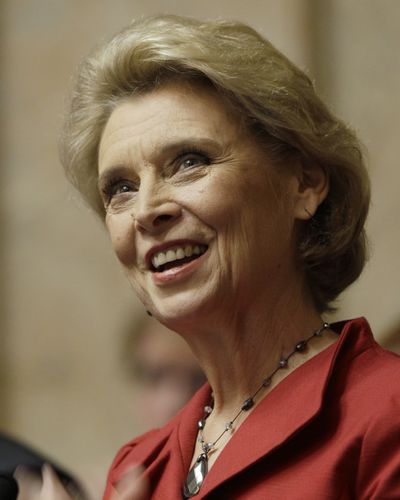Gregoire after more tourist cash
Western states need to do more, she says

WASHINGTON – When she leaves the executive mansion as Washington state’s 22nd governor next January, Democrat Chris Gregoire wants to unwind by taking a month to visit some national parks with her husband, Mike.
She’s hoping that more foreign tourists will do the same.
While global tourism rose by 40 percent in the past decade, Gregoire said that the number of overseas travelers who came to the United States increased by only 1 percent from 2000 to 2010.
According to the White House, both the travel industry and Bureau of Economic Analysis say that international travel is particularly important as overseas or “long-haul” travelers spend on average $4,000 on each visit.
Gregoire said cash-strapped states need to lure more such visitors. She said Western states, with an abundance of spectacular scenery and parkland, are best suited to pull them in.
“That’s where real money is made,” Gregoire said in an interview.
It’s a message that Gregoire will carry as the nation’s governors gather in Washington for their annual winter meetings, which opened Saturday.
For Gregoire, who turns 65 next month, it will be the eighth and final winter meeting of the National Governors Association, and it’s a time of change. Last year she headed the organization, and now she’s a lame duck.
Gregoire, who arrived in Washington on Thursday and plans to leave Monday night, will get a chance to spread her “Get Out West!” message as the new chairwoman of the Western Governors’ Association, which includes 19 states. She put together a meeting for today with some top Cabinet officials, including Interior Secretary Ken Salazar, who also is out to increase traffic to the 397 national parks.
After leading trade missions to such places as China, Japan, Korea, France, Germany and England, Gregoire said she has discovered that many foreign visitors “are not necessarily coming anymore to see New York City or Disneyland.”
“There is a kind of sense you get from folks – no offense intended here – that they really want to see a more natural America,” Gregoire said. “They are coming to see the out-of-doors, and the real culture and history associated with that.”
Gregoire said China has a huge and growing middle class that’s eager to experience the United States. To make it easier, she wants the United States to negotiate an agreement with China that would extend visas for Chinese travelers from one to five years.
And she’d like to expand the U.S. visa waiver program to include China, Poland, Brazil and Chile. The program allows nationals from 36 countries to come to the United States for tourism or business and stay up to 90 days without getting a visa.
But she said one of the biggest obstacles for states is simply that they’re not doing enough to woo foreign travelers.
“Embarrassingly, I will tell you in these tough economic times, we’ve cut our funding of promoting tourism,” she said. “We’ve turned to our industry and literally begged them, ‘Please, pick up where’s we’ve left off.’ … We just can’t provide state funding anymore.”
Last month, President Barack Obama signed an executive order calling for a new strategy to make the United States the world’s top travel destination. He said that international travel alone supports 1.2 million jobs in the country and that the number could nearly double in the next decade if the United States expands its market share.
As part of the strategy, Obama asked Salazar and Commerce Secretary John Bryson to lead a task force to come up with new recommendations, including a plan to increase the more than 400 million visits to national parks and wildlife refuges in 2010.
The White House noted that those visits contributed nearly $50 billion in economic activity and 400,000 jobs, with ecotourism and outdoor recreation having “an outsize impact on rural economies,” particularly in North Carolina, California, Florida, Arizona, Colorado, Nevada, Oregon, Utah and Wyoming.
At a House committee hearing last week, Salazar called the national parks “the envy of the world” and asked Congress to approve a plan to use $212 million in public funds to buy land for more parks and wildlife refuges, including sites to commemorate the Civil War. And he said the Interior Department wants permission to buy more land with $450 million from the nation’s Land and Water Conservation Fund, a separate fund that relies on royalties from oil and gas drilling.
In Washington state, the department wants to use $1 million from the special fund to acquire 226 acres to expand Mount Rainier National Park, and another $1 million to pay for a 201-acre expansion of the Nisqually National Wildlife Refuge.
Gregoire said the president’s order has already “put a sense of urgency” behind the effort.
But she said she also wants to aim her message at domestic tourists. She credited them with aiding the Washington state economy during tough times by spending on fishing rods, guns, outdoor clothing and equipment, and the like.
“It’s pretty resilient to the recession,” she said.
Gregoire counts herself as an outdoors enthusiast, one who loves camping, hiking, downhill skiing and waterskiing. Last year, she said, her two daughters scaled Mount Rainier.
“I have to tell you: Underlying all of this is to try to get families to go out and experience the out-of-doors together, to get away from the computer and the games that they play indoors … to connect, talk, and experience something really quite positive together,” she said.